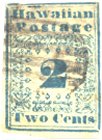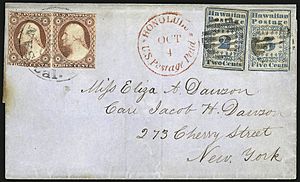Hawaiian Missionaries (stamps) facts for kids
Quick facts for kids Hawaiian "Missionaries" |
|
|---|---|
 |
|
| Country of production | Kingdom of Hawaii |
| Location of production | The Polynesian Honolulu |
| Date of production | 1851 |
| Nature of rarity | Few exist |
| No. in existence | 15 |
| Face value | Two cents |
| Estimated value |
|
The Hawaiian Missionaries are the very first postage stamps ever made by the Kingdom of Hawaii. They were released in 1851. People started calling them "Missionaries" because they were mostly found on letters sent by missionaries living in the Hawaiian Islands.
Only a few of these stamps still exist today. This makes them some of the rarest and most valuable stamps for stamp collectors.
Contents
How These Stamps Started
In the early 1800s, sending mail to and from Hawaii was tricky. Ship captains would carry letters whenever they could. By 1849, more people were sending mail. This was partly because of the California Gold Rush and new settlements in California.
To handle all the extra mail, the Hawaiian government opened a post office. They also set prices for sending letters. In June 1851, Henry Martyn Whitney became the first postmaster. He was given permission to print the new stamps. He used the printing press of The Polynesian, which was a weekly government newspaper.
About the Stamps
The Hawaiian Missionary stamps first went on sale on October 1, 1851. They came in three different values, called "denominations," to cover different mailing costs:
- The 2-cent stamp was for sending newspapers to the United States.
- The 5-cent stamp was for regular letters going to the United States.
- The 13-cent stamp was for mail going all the way to the East Coast of the United States. This stamp covered the 5 cents for Hawaiian postage, a 2-cent ship fee, and 6 cents for the mail journey across the U.S.
Stamp Design and Paper
The stamps had a very simple design. Each stamp showed a large number for its value in the middle. This number was surrounded by a decorative border. The value was also written in words at the bottom.
The top of the 2-cent and 5-cent stamps said "Hawaiian / Postage." But the 13-cent stamp said "H.I. & U.S. / Postage." This showed that it paid for postage in both Hawaii and the United States. A thin line inside a thicker line framed the whole stamp.
All the stamps were printed in the same shade of blue. They were printed on a very thin, tissue-like paper called pelure paper. This paper tore easily. Because of this, about 90% of the Missionary stamps known today have some damage.
How Rare Are They?
These stamps were used regularly until about 1856. However, out of the four values made, only about 200 have survived. Only 28 of these are unused, and 32 are still attached to their original envelopes, known as "covers."
The 2-cent stamp is the rarest of all the Hawaiian Missionaries. Only 15 copies of it are known to exist. Just one of these 15 stamps is unused. This single unused 2-cent stamp has been sold for very high prices over the years. In 1963, it sold for $41,000, which was the highest price ever paid for any stamp at that time.
The 1963 movie Charade features valuable stamps. In the movie, a character uses a 3-cent Hawaiian Missionary stamp to hide stolen money. This was meant to represent the much rarer 2-cent value.
The Dawson Cover
One of the most valuable Missionary items is a special envelope called the Dawson Cover. This envelope was sent to New York City. It is important because it has the only known 2-cent Missionary stamp ever used on an envelope. It also has a 5-cent Missionary stamp and two 3-cent U.S. stamps.
The Dawson Cover was found in a bundle of letters that had been put into a factory furnace around 1870. Luckily, the bundle was packed so tightly that the fire went out. One side of the envelope still has a scorch mark from the fire. Thirty-five years later, a worker cleaning the abandoned factory found the furnace. He knew enough about stamps to save the unusual envelopes.
This cover has been sold many times for very high prices. In 1995, it sold for over $2 million. In 2013, it sold for $2.24 million, making it one of the most expensive stamp items ever.
The Dawson Cover also helps show that a treaty between the United States and Hawaii was working. This treaty, signed in 1850, allowed mail to be exchanged between the two countries. It helped Hawaii show it was a sovereign nation (an independent country).
The Grinnell Missionaries
In 1920, 43 more Missionary stamps suddenly appeared on the market. These stamps came from Charles Shattuck, whose mother had exchanged letters with a missionary family in Hawaii. George H. Grinnell bought these stamps, and then sold them to a dealer for $65,000.
However, in 1922, people questioned if these stamps were real. A court case decided that they were fakes. Experts at the time said the Grinnell stamps were made using a different printing method than the original Missionaries.
Later studies have looked at the Grinnell stamps again. Some experts now believe they might have been made using the correct printing method. Also, the ink and paper used for the Grinnell stamps seem to be from the 1850s. Even with these new findings, the Royal Philatelic Society London, a group of stamp experts, still declared the stamps to be fake.
In 2006, the Mystic Stamp Company announced they had bought 36 of the Grinnell stamps. They offered to sell the group for $1.5 million, even though their authenticity is still debated.
Many of the original Missionary stamps that still exist today have been repaired. Experts believe they probably wouldn't have survived if they hadn't been fixed.
Images for kids




